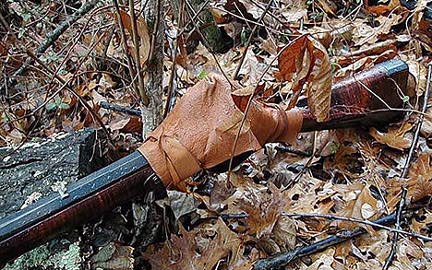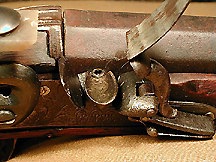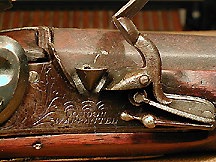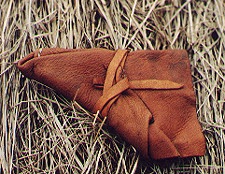

Wet weather has been a problem for flintlock shooters since the lock was invented in about 1610. Those of us us who favor that ignition system in today's world are faced with the same difficulties, and it seems that many of us never overcome them. That's too bad. It is a real disappointment to have gotten in position to take a nice deer or elk and fail to do so because the pan is full of slush, instead of the good dry prime we need. Disappointing, but almost totally avoidable. Wet weather flintlock shooting is a learned skill, and we can overcome the problem with the application of a little thought and effort.
The design of the lock is one important consideration. There is a type of lock known as "waterproof", which, of course, isn't. No lock is totally waterproof, but this type is engineered so that there is no excess pan exposed below the frizzen, and this helps prevent channeling of water into the pan. I would select this type for a gun I knew was going to be subjected to foul weather regularly, if it were possible. It usually isn't.


The ordinary lock most of us use has a wide flange around the pan, and this mates with the bottom, or foot, of the frizzen when the frizzen is closed. This joint is a frequent source of trouble. Take your lock off and hold it up to the light so you are looking at that joint. If you can see light between the flange of the pan and the foot of the frizzen, you need to do some work. This joint needs to mate exactly, so that no light will be visible. Some careful filing and stoning will usually make that happen. Remove the frizzen from the lock and work at it slowly, and it's not a difficult job to make both sides perfectly flat, as they need to be.
In his series of tests of locks, reported in Muzzleloader, Peter Alexander did a 'wet' test of each lock. He primed the pan and closed the frizzen, then put his finger over the opening where the pan communicates with the flash-hole. He then submerged the lock completely in water and held it there for one full minute. He then took it out, blew off any excess water, turned the lock upside down and fired it. Most of the locks he tested passed the test, and yours should, too, if you've done a proper job of mating that joint.
 Once you are satisfied with the lock, there are other things you need to do
to help assure reliable ignition. One of the most important is to check for
"channeling" of water into the lock. On most guns, water can run down along
the barrel, in the joint where the stock and barrel meet, and straight into
the pan. This can happen even if you are protecting the lock from being
directly rained on with a cow's knee, or some such. You can tell by looking
whether this is possible with your gun. If so, then it's easy to fix.
Before you go out into the rain/snow, fill that joint with some of your
paste patch lubricant, Wonderlube, homebrew, or whatever. Fill it up for
about a foot in front of the lock. This will divert any water away from the
lock. You can also help prevent this by carrying the gun in a slightly
muzzle-down position as much as possible.
Once you are satisfied with the lock, there are other things you need to do
to help assure reliable ignition. One of the most important is to check for
"channeling" of water into the lock. On most guns, water can run down along
the barrel, in the joint where the stock and barrel meet, and straight into
the pan. This can happen even if you are protecting the lock from being
directly rained on with a cow's knee, or some such. You can tell by looking
whether this is possible with your gun. If so, then it's easy to fix.
Before you go out into the rain/snow, fill that joint with some of your
paste patch lubricant, Wonderlube, homebrew, or whatever. Fill it up for
about a foot in front of the lock. This will divert any water away from the
lock. You can also help prevent this by carrying the gun in a slightly
muzzle-down position as much as possible.
If you want to be extra certain, before you prime your piece, smear a thin coat of your paste lube on that pan/frizzen joint discussed earlier. Don't go to extremes, just make certain the entire joint is covered. With a good fit and a thin coat of grease, water will not enter.
 On March 15, 1759, General Amherst, Commander in Chief of all British Forces in North America during the Seven Years (F&I) War, gave the following order while soliciting men for a campaign: "And every Man, is to be well clothed, and be furnished with a good Firelock, Powder Horn, Shot Bag, and Cover for the Lock of his Gun, with three Pound of Ball fit for his Gun, and a good Blanket". That "Cover for the Lock of his Gun" is called a cow's knee, today, but serves the same purpose now as then, to keep the lock dry in wet weather. No one who shoots a flintlock in the rain or snow should be without a cow's
knee, some kind of leather cover to put over the lock. Treat it thoroughly
with grease or wax. I use my regular beeswax-lard patch lube, but
have used Sno-Seal for years with good results. Make it simple in design,
small and convenient to carry and simple to use. If it's complicated or
difficult to use, you won't. They work very well, indeed, but not if they
are in your shooting pouch.
On March 15, 1759, General Amherst, Commander in Chief of all British Forces in North America during the Seven Years (F&I) War, gave the following order while soliciting men for a campaign: "And every Man, is to be well clothed, and be furnished with a good Firelock, Powder Horn, Shot Bag, and Cover for the Lock of his Gun, with three Pound of Ball fit for his Gun, and a good Blanket". That "Cover for the Lock of his Gun" is called a cow's knee, today, but serves the same purpose now as then, to keep the lock dry in wet weather. No one who shoots a flintlock in the rain or snow should be without a cow's
knee, some kind of leather cover to put over the lock. Treat it thoroughly
with grease or wax. I use my regular beeswax-lard patch lube, but
have used Sno-Seal for years with good results. Make it simple in design,
small and convenient to carry and simple to use. If it's complicated or
difficult to use, you won't. They work very well, indeed, but not if they
are in your shooting pouch.
A lot of people search constantly for a magic additive to mix with their priming powder to waterproof it. That's totally unnecessary, a waste of good money and an unneeded hassle. If dry prime is put into a dry pan, and the methods mentioned above are adhered to, a flintlock will fire every time, in rain or snow. The biggest mistake most people make is in not cleaning the pan thoroughly after every shot on those wet or humid days. If you are not going to shoot again immediately, the pan must be cleaned of *every last bit* of the residue of the last shot, because the salts left from burning black powder are strongly hygroscopic, and will suck moisture out of the air like a sponge, on some days. Good quality unburned black powder is not hygroscopic enough to cause any problem, and it will stay useable in the pan for hours and hours on the most humid day. If you mechanically exclude liquid water by the steps mentioned, and start with dry prime and a clean pan, the gun will fire.
I know, I know, lot of people will disagree with the statement that black powder isn't hygroscopic. You are free to do so. I've hunted for years in extreme humidity, rain and snow, and have proven to my own satisfaction that the statement is correct. I have never once, not a single time, had a flintlock fail to fire because dry powder in a clean, dry pan had absorbed enough moisture from humid air to prevent ignition.
The only priming powder I've ever used is plain old FFFFg, most of it Hodgens or Goex.
In a discussion of this subject on the MLML, some good suggestions were made which need to be included here. Bill White pointed out that a rough, unpolished pan affords a multitude of tiny crevasses and cracks, each of which is a perfect hiding place for the salts left in the residue of the burned prime. Polishing the pan markedly reduced the problem he was having with soup in the pan after firing. He used crocus cloth on his finger, and a Dremel tool with rubber polishing tips to make the pan as shiny smooth as possible. Roger Lahti feels that FFFg powder used as prime has less tendency to draw moisture. Thomas Crooks warns that a ramrod can swell with moisture and stick in the ramrod channel, and should be sealed to prevent this. He also says, "Do not use the type of primer container that relies on being pressed into the pan to dump the priming. Moisture will work its way into the nozzle and plug it up. Use something you actually pour from and does not touch the pan's surface." And: "In driving rain, shelter the neck of your powder horn from the water. I found that water accumulated around the neck and plug, and, when I unstoppered the horn to load, the little bit of water was enough to wet the powder and partially block the neck of the horn--had to use my vent pick to clear it out."
Some of the most enjoyable days afield I've ever experienced have been rainy, snowy days. There is something special about them, a different feel, a different look. The hunting can be very good, too. Whenever such an opportunity presents itself, I never hesitate to take advantage of it, and I never worry that my flintlock will let me down because of the wet. I've carried it all day in constant rain, many times, and had it fire instantly at the end of the day. Many of those times, that end-of-the-day shot was fired using the prime I put in early in the morning.
A flintlock is a marvelous machine. There are some disadvantages to them, some handicaps. I'm firmly convinced, though, that we create many of them by not knowing how to use the guns correctly. Shooting in the rain is certainly one of those problems which can be overcome with a little thought and effort.
Copyright © 1998 B.E. Spencer, all rights reserved. Photo #4 by Chuck Phelps.
Back to The Notebook